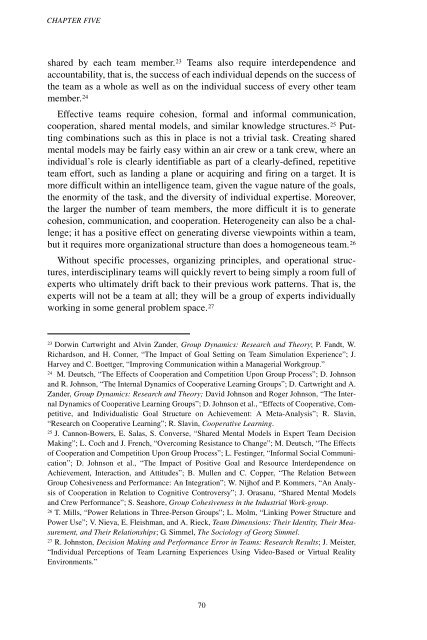Analytic Culture in the U.S. Intelligence Community (PDF) - CIA
Analytic Culture in the U.S. Intelligence Community (PDF) - CIA
Analytic Culture in the U.S. Intelligence Community (PDF) - CIA
Create successful ePaper yourself
Turn your PDF publications into a flip-book with our unique Google optimized e-Paper software.
CHAPTER FIVE<br />
shared by each team member. 23 Teams also require <strong>in</strong>terdependence and<br />
accountability, that is, <strong>the</strong> success of each <strong>in</strong>dividual depends on <strong>the</strong> success of<br />
<strong>the</strong> team as a whole as well as on <strong>the</strong> <strong>in</strong>dividual success of every o<strong>the</strong>r team<br />
member. 24<br />
Effective teams require cohesion, formal and <strong>in</strong>formal communication,<br />
cooperation, shared mental models, and similar knowledge structures. 25 Putt<strong>in</strong>g<br />
comb<strong>in</strong>ations such as this <strong>in</strong> place is not a trivial task. Creat<strong>in</strong>g shared<br />
mental models may be fairly easy with<strong>in</strong> an air crew or a tank crew, where an<br />
<strong>in</strong>dividual’s role is clearly identifiable as part of a clearly-def<strong>in</strong>ed, repetitive<br />
team effort, such as land<strong>in</strong>g a plane or acquir<strong>in</strong>g and fir<strong>in</strong>g on a target. It is<br />
more difficult with<strong>in</strong> an <strong>in</strong>telligence team, given <strong>the</strong> vague nature of <strong>the</strong> goals,<br />
<strong>the</strong> enormity of <strong>the</strong> task, and <strong>the</strong> diversity of <strong>in</strong>dividual expertise. Moreover,<br />
<strong>the</strong> larger <strong>the</strong> number of team members, <strong>the</strong> more difficult it is to generate<br />
cohesion, communication, and cooperation. Heterogeneity can also be a challenge;<br />
it has a positive effect on generat<strong>in</strong>g diverse viewpo<strong>in</strong>ts with<strong>in</strong> a team,<br />
but it requires more organizational structure than does a homogeneous team. 26<br />
Without specific processes, organiz<strong>in</strong>g pr<strong>in</strong>ciples, and operational structures,<br />
<strong>in</strong>terdiscipl<strong>in</strong>ary teams will quickly revert to be<strong>in</strong>g simply a room full of<br />
experts who ultimately drift back to <strong>the</strong>ir previous work patterns. That is, <strong>the</strong><br />
experts will not be a team at all; <strong>the</strong>y will be a group of experts <strong>in</strong>dividually<br />
work<strong>in</strong>g <strong>in</strong> some general problem space. 27<br />
23<br />
Dorw<strong>in</strong> Cartwright and Alv<strong>in</strong> Zander, Group Dynamics: Research and Theory; P. Fandt, W.<br />
Richardson, and H. Conner, “The Impact of Goal Sett<strong>in</strong>g on Team Simulation Experience”; J.<br />
Harvey and C. Boettger, “Improv<strong>in</strong>g Communication with<strong>in</strong> a Managerial Workgroup.”<br />
24<br />
M. Deutsch, “The Effects of Cooperation and Competition Upon Group Process”; D. Johnson<br />
and R. Johnson, “The Internal Dynamics of Cooperative Learn<strong>in</strong>g Groups”; D. Cartwright and A.<br />
Zander, Group Dynamics: Research and Theory; David Johnson and Roger Johnson, “The Internal<br />
Dynamics of Cooperative Learn<strong>in</strong>g Groups”; D. Johnson et al., “Effects of Cooperative, Competitive,<br />
and Individualistic Goal Structure on Achievement: A Meta-Analysis”; R. Slav<strong>in</strong>,<br />
“Research on Cooperative Learn<strong>in</strong>g”; R. Slav<strong>in</strong>, Cooperative Learn<strong>in</strong>g.<br />
25<br />
J. Cannon-Bowers, E. Salas, S. Converse, “Shared Mental Models <strong>in</strong> Expert Team Decision<br />
Mak<strong>in</strong>g”; L. Coch and J. French, “Overcom<strong>in</strong>g Resistance to Change”; M. Deutsch, “The Effects<br />
of Cooperation and Competition Upon Group Process”; L. Fest<strong>in</strong>ger, “Informal Social Communication”;<br />
D. Johnson et al., “The Impact of Positive Goal and Resource Interdependence on<br />
Achievement, Interaction, and Attitudes”; B. Mullen and C. Copper, “The Relation Between<br />
Group Cohesiveness and Performance: An Integration”; W. Nijhof and P. Kommers, “An Analysis<br />
of Cooperation <strong>in</strong> Relation to Cognitive Controversy”; J. Orasanu, “Shared Mental Models<br />
and Crew Performance”; S. Seashore, Group Cohesiveness <strong>in</strong> <strong>the</strong> Industrial Work-group.<br />
26<br />
T. Mills, “Power Relations <strong>in</strong> Three-Person Groups”; L. Molm, “L<strong>in</strong>k<strong>in</strong>g Power Structure and<br />
Power Use”; V. Nieva, E. Fleishman, and A. Rieck, Team Dimensions: Their Identity, Their Measurement,<br />
and Their Relationships; G. Simmel, The Sociology of Georg Simmel.<br />
27<br />
R. Johnston, Decision Mak<strong>in</strong>g and Performance Error <strong>in</strong> Teams: Research Results; J. Meister,<br />
“Individual Perceptions of Team Learn<strong>in</strong>g Experiences Us<strong>in</strong>g Video-Based or Virtual Reality<br />
Environments.”<br />
70
















